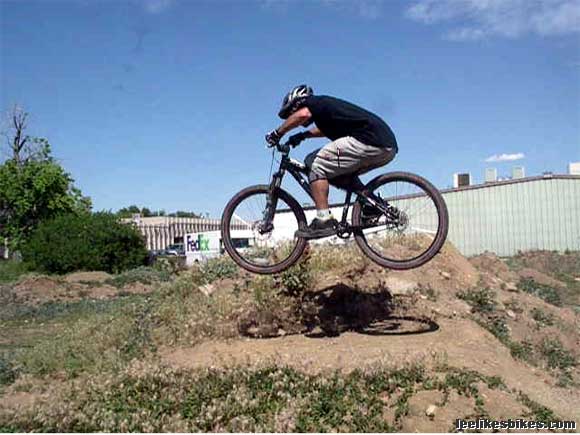Controlling mid-air rotation

A reader wants to avoid endos and loop-outs when he jumps his bike. That sounds like a good idea; here’s how.
Hi Lee.
I thoroughly enjoy and appreciate your book; it has helped my riding immensely. I was hoping to get some tips from you regarding having better control of my fore-aft rotation — or sudden correction of — while jumping. I consider myself to be an intermediate jumper with progressing skills. I pretty much stick to tables, hips, etc. so I can work it up little at a time without much penalty of coming up short.
I’ve had several close calls and one nasty crash from over-rotating. I do know that complete relaxation is key and have found that out for myself — along with adjusting for all of the variables of different types of jumps. I’m 38 years old and don’t feel the need to clear huge road gaps or bust out fancy tricks in the air, but I would like to be able to consistently jump moderate doubles with flow and some style.
Thanks for all you’ve done for the sport and I look forward to your response.
Aaron
Hey Aaron.
Thanks for your note. The key here, as with most riding techniques, is body position.
 Me on a training jump at The Fix. At apogee I’m balanced on my pedals and as tiny as possible — as if I’m sucking up a huge roller. |
I’m going to guess you jump with straight arms and legs, and that you keep them that way until you land. That’s fine if everything’s perfect: pitch, yaw, timing, etc. But if anything is off, you’re screwed. With your limbs extended you can’t make corrections. If you take off leaning to the left, you land that way. If you take off nose-heavy, you land that way. Not cool!

|
Approach the lip in a neutral position, with all your weight in your feet. Using your legs, press into the lip to load your bike. This is like jumping off a diving board.
As soon as you take off, let your bike rise into your body. In mid-air you’ll be super low on your bike, with your arms and legs bent. See the above photo. It’s an exaggeration, but do you see what I’m talking about?
From here, you can easily adjust the attitude of your bike.
– Nose too high: Extend your arms.
– Nose too low: Extend your legs.
– Time to land: Extend your arms then your legs.
Jumping is dynamic. Don’t hold any one position for more than an instant. Spring up, get small, then extend for landing. As long as you stay loose, this gives you great flight control. This is huge: STAY BALANCED ON YOUR FEET, and let your bike rotate under you.
Check out the flowy-flow in this photo series.

Comments are closed.